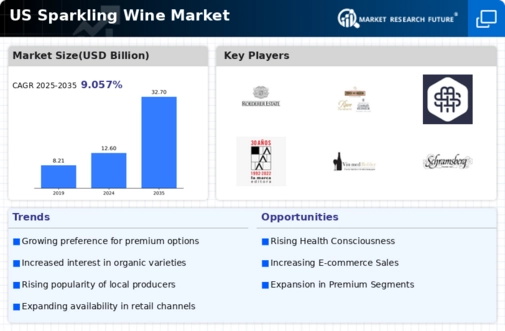Innovative Marketing Strategies
In the competitive landscape of the sparkling wine market, innovative marketing strategies are becoming increasingly vital for brand differentiation. Companies are leveraging digital platforms and social media to engage with consumers, showcasing their products through visually appealing content and storytelling. This approach not only enhances brand visibility but also fosters a deeper connection with potential customers. For instance, targeted advertising campaigns have shown to increase brand awareness by up to 25% among younger demographics. Additionally, collaborations with influencers and participation in experiential events are proving effective in attracting new consumers. As brands adapt to changing consumer preferences, the use of innovative marketing techniques is likely to play a crucial role in driving growth within the sparkling wine market, ensuring that brands remain relevant and appealing to a diverse audience.
E-commerce Growth and Online Sales
The sparkling wine market is witnessing a significant transformation due to the rapid growth of e-commerce and online sales channels. As consumers increasingly turn to online platforms for their purchasing needs, the convenience and accessibility of buying sparkling wines online are reshaping the market landscape. In 2025, online sales are projected to account for nearly 30% of total sparkling wine sales, highlighting a shift in consumer behavior towards digital shopping. This trend is further supported by the rise of subscription services and direct-to-consumer models, which provide consumers with curated selections and personalized experiences. As retailers and producers enhance their online presence, the sparkling wine market is likely to benefit from increased sales and a broader reach, allowing brands to connect with consumers in innovative ways.
Rising Consumer Interest in Quality
The sparkling wine market is experiencing a notable shift towards quality over quantity, as consumers increasingly seek premium products. This trend is reflected in the growing demand for high-quality sparkling wines, which has led to a surge in sales of premium brands. In 2025, the market for premium sparkling wines is projected to account for approximately 35% of total sales, indicating a significant preference for superior offerings. This consumer behavior is driven by a desire for unique flavors and artisanal production methods, which enhances the overall drinking experience. As a result, producers are focusing on quality ingredients and traditional production techniques to meet this demand, thereby elevating the status of sparkling wines in the beverage industry. The emphasis on quality is likely to continue shaping the sparkling wine market, as consumers become more discerning in their choices.
Cultural Celebrations and Social Events
Cultural celebrations and social events continue to drive demand within the sparkling wine market, as these occasions often call for celebratory beverages. The association of sparkling wine with festivities, such as weddings, holidays, and milestone events, reinforces its status as a preferred choice for consumers. In 2025, it is estimated that approximately 40% of sparkling wine sales will be attributed to special occasions, underscoring the beverage's role in social gatherings. This trend is further amplified by the growing popularity of brunch and casual gatherings, where sparkling wines are increasingly featured. As consumers seek to enhance their social experiences, the sparkling wine market is likely to thrive, driven by the ongoing demand for products that complement celebratory moments.
Health Consciousness and Low-Alcohol Options
The increasing health consciousness among consumers is influencing the sparkling wine market, as more individuals seek lower-alcohol alternatives. This trend is evident in the rising popularity of low-alcohol and non-alcoholic sparkling wines, which cater to health-oriented consumers who still wish to enjoy the celebratory aspects of sparkling beverages. In 2025, the segment of low-alcohol sparkling wines is expected to grow by approximately 15%, reflecting a shift in consumer preferences towards moderation. This change is prompting producers to innovate and create products that align with health trends while maintaining the quality and taste that consumers expect. As the market evolves, the introduction of these options is likely to attract a broader audience, including those who may have previously avoided traditional sparkling wines due to alcohol content.



















Leave a Comment